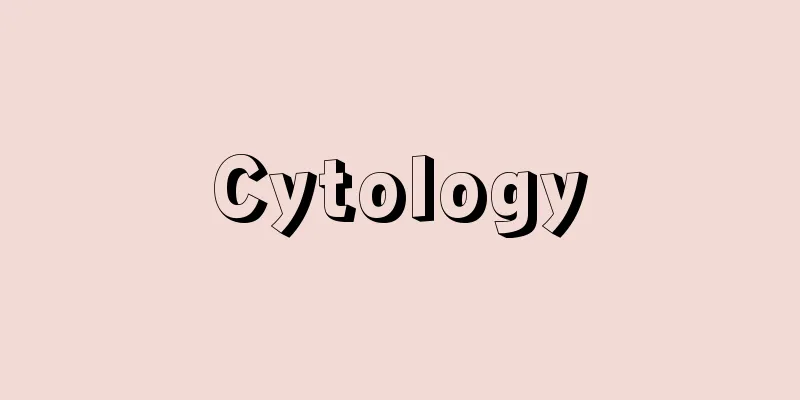Cytology

|
The science that studies the morphology and function of cells. Most biological phenomena are related to the properties of the cells that are their building blocks, so cytology is an important branch of biology. However, since the establishment of cytology, the emphasis has been on morphological research, and as research on function has become more common in recent years, the new term "cell biology" has come to be used more often. [Hiroshi Ooka] historyThe history of cytology began with the discovery of cells by R. Hooke of England in 1665, but the biological significance of cells was hardly understood before a series of studies from the late 18th century to the early 19th century. It is generally known that the cell theory was established by Schleiden in 1838 and Schwann in 1839 (both Germans), but the cellular structure of living organisms had been recognized by German scholars C. F. Wolff and others as early as 1759. R. Brown of England described the nucleus in 1831, H. von Moll of Germany in 1835, and W. Fleming of Germany in 1882. Hertwig of Germany observed fertilization in 1875, and the concept of animal and plant germ cells was established in 1894 by Strassburger and others of the same German. Furthermore, the discovery of meiosis by Beneden in Belgium in 1883 and A. Weissmann in Germany in 1887 laid the foundation for the American T. H. Morgan to complete the chromosome theory of inheritance in 1919. Meanwhile, research into the structure of the cytoplasm also progressed, with mitochondria, the Golgi apparatus, and plastids being described by the beginning of the 20th century. The practical application of electron microscopes after World War II brought about a dramatic advance in the study of ultrastructural structure, providing important insights into the structures of ribosomes, endoplasmic reticulum, nuclear membrane, cell membrane, as well as mitochondria and plastids. Isolation of these organelles and biochemical studies of their properties clarified the relationship between form and function, and this field came to be expressed under the new concept of "cell biology." [Hiroshi Ooka] Research FieldThe main areas of research in cytology include the observation of cell morphology that makes up various animal and plant tissues using light microscopes and a variety of staining methods, the study of the fine structure of intracellular organelles using electron microscopes, cytochemistry, which detects specific substances and enzymes through staining in microscopic specimens, cytogenetics, which studies karyotypes by preparing chromosome specimens from dividing cells, and the observation of tissues and cultured living cells using phase-contrast microscopes.In addition to these, research is being conducted using new techniques such as fluorescence microscopes, interference microscopes, polarizing microscopes, scanning electron microscopes for observing cell surfaces, autoradiography using radioactive isotopes, and immunocytochemistry, which detects substances using antibodies. [Hiroshi Ooka] [Reference Item] |Source: Shogakukan Encyclopedia Nipponica About Encyclopedia Nipponica Information | Legend |
|
細胞の形態および機能を研究する学問。生物現象のほとんどはその構成単位である細胞の性質に関連をもつので、細胞学は生物学の重要な一分野をなす。しかし細胞学とよぶ場合には、その成立過程から形態研究に重点が置かれていたため、近年機能に関する研究が盛んになるにつれて「細胞生物学」という新しい呼び方が多く用いられるようになった。 [大岡 宏] 歴史細胞学の歴史は1665年イギリスのR・フックによる細胞の発見に始まるが、細胞の生物学的な意義は18世紀末から19世紀初めにかけての一連の研究以前はほとんど理解されなかった。一般には1838年のシュライデン、翌1839年のシュワン(いずれもドイツ人)による細胞説の確立が知られているが、それ以前の1759年にもドイツのC・F・ウォルフその他の学者によって生物体の細胞構成が認められていた。イギリスのR・ブラウンは1831年に核を記述し、ドイツのH・von・モールは1835年に、W・フレミングは1882年に有糸分裂を観察した。またドイツのヘルトウィヒは1875年に受精を観察し、同じドイツのシュトラスブルガーらにより1894年に動物・植物の生殖細胞の概念が確立された。さらに1883年にベルギーのベネデン、1887年にドイツのA・ワイスマンらによってなされた減数分裂の発見は、1919年にアメリカのT・H・モーガンが遺伝の染色体説を完成させる基礎となった。一方細胞質の構造の研究も進み、20世紀初めまでにミトコンドリア、ゴルジ装置、色素体が記述された。第二次世界大戦後における電子顕微鏡の実用化は微細構造の研究に飛躍的な進歩をもたらし、リボゾーム、小胞体、核膜、細胞膜、さらにミトコンドリアや色素体の構造などに重要な知見が得られた。これらの小器官の分離とその性質の生化学的研究は形態と機能の関係を明らかにし、この分野は「細胞生物学」という新しい概念で表現されるようになった。 [大岡 宏] 研究分野細胞学のおもな研究分野としては、各種の染色法を用いていろいろな動植物組織を構成する細胞形態の光学顕微鏡による観察、電子顕微鏡による細胞内小器官の微細構造の研究、顕微鏡標本の上で染色によって特定の物質や酵素を検出する細胞化学、分裂中の細胞から染色体標本をつくって核型を研究する細胞遺伝学、位相差顕微鏡による組織や培養された生きた細胞の観察などがあるが、これらに加えて蛍光顕微鏡、干渉顕微鏡、偏光顕微鏡、細胞表面を観察する走査電子顕微鏡、放射性同位元素を用いたオートラジオグラフィー、抗体によって物質を検出する免疫細胞化学など新しい技術を駆使した研究が行われている。 [大岡 宏] [参照項目] |出典 小学館 日本大百科全書(ニッポニカ)日本大百科全書(ニッポニカ)について 情報 | 凡例 |
Recommend
Aarhus - Århus (English spelling)
A city on the east coast of the Jutland Peninsula...
Tengu Haikai
A game of haiku poetry. Three people create a vers...
Theory of functions
A type of music theory. The idea that chords in ma...
Gakunan Liberal Party
…In 1883-84, Matsukata's deflationary policy ...
Seibu - Saimu
Date of birth and death unknown. A haiku poet of ...
Louis XIV - Louis
King of France (reigned 1643-1715). Son of Louis X...
Ozeki Takamasu - Ozeki Takamasu
…The Ozeki clan originated from a powerful local ...
Harumi Shibukawa
Year of death: 6th October 1715 (1st November 1715...
Period division - Jidai-ku-bun
Human life is the same every day. Today is a cont...
Princess Sarara of Uno
⇒ Empress Jitō Source: Kodansha Digital Japanese N...
Yamagata [town] - Yamagata
An old town in Naka-gun, in the middle reaches of ...
Abominable Snowman
…An unidentified human-like creature said to live...
Argentine tango (English spelling)
Tango created by Argentine and Uruguayan composer...
regulator
...a clock used to keep standard time. Historical...
Diabetes in children and adolescents
What is the disease? This is diabetes that develo...









